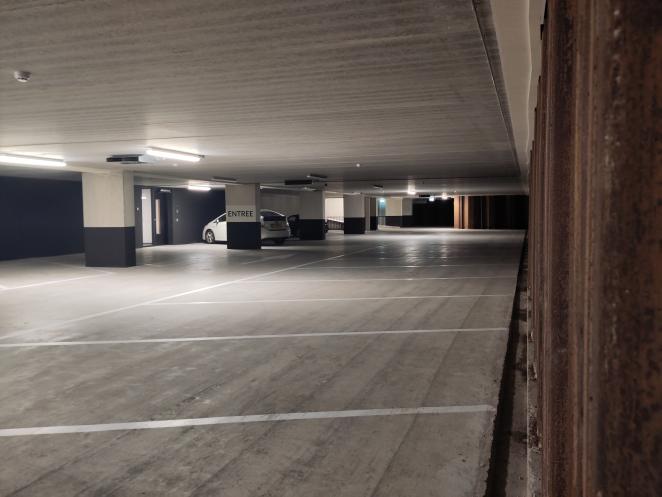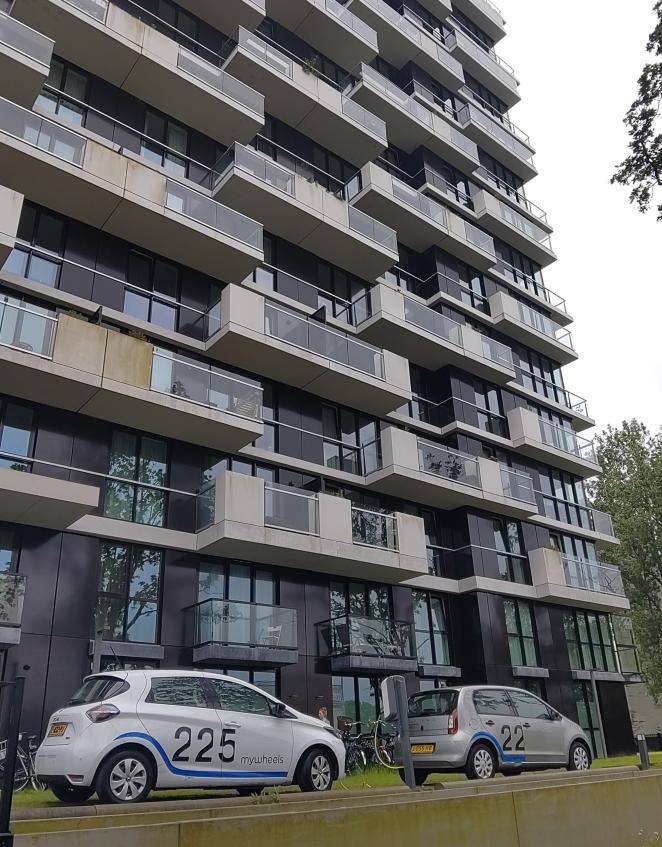Shared mobility can reduce parking norms, enhance livability, and significantly improve the feasibility of residential developments. TwoTwoFive, a residential building in Amstelveen, is one such success story. In this article, one of our partners: autodelen.net explores the challenges of the project, the solutions, and the lessons they can learn for new residential developments in Flanders. This blog was created for a study visit in the Netherlands as part of the SHARE-North Squared project of the Interreg North Sea Region.

A little background
TwoTwoFive, completed in 2022, consists of 276 rental apartments, combining luxury and sustainability with affordability for residents. The project emerged as a pilot within the City Deal 'Electric Shared Mobility in Urban Development.' The municipality of Amstelveen aimed to create affordable housing with ample green space and to promote electric driving and shared mobility, which were still in their infancy at the time.
The parking norm in Amstelveen, a municipality with high car ownership, ranged from 1.4 to 2 parking spaces per dwelling. TwoTwoFive was originally an office building on a 3000m² plot, with 2000m² entirely paved for parking. Traditionally, this would mean 200 above-ground parking spaces and thus 100 dwellings. However, by lowering the parking norm from 1.4 to 0.75, the developer could create 276 dwellings.

The solution: fewer parking spaces, more shared mobility
The developer opted for an underground parking garage, making the rest of the site unpaved and climate-resilient. The three-level garage accommodates 200 cars and is equipped with charging points for electric cars and bicycles. This was a costly provision: the garage cost a whopping 11 million euros. Divers worked for a year to pour underwater concrete into the soft ground, bringing the cost per parking space to 55,000 euros.
Naturally, shared mobility is a crucial piece of the puzzle in this project. Upon completion, 10 electric shared cars from Mywheels were available for residents. These cars, notably marked with the number combination 225, were parked above ground to increase visibility and attractiveness.

Results
After more than two years, the results are impressive on several fronts.
- Feasible Housing Project: The parking norm is a crucial instrument to make housing projects more feasible for developers, as they do not have to build unnecessarily expensive parking spaces. The parking garage under TwoTwoFive had a maximum size. Without shared mobility and a reduced parking norm, the building would have had to be much smaller, creating fewer homes.
- Profitable Shared Cars: Today, the shared cars are fully funded by the users. The municipality or developer do not subsidize the costs. The cars are used by more than half of the residents, even though a core group of users makes the majority of trips.
- Low Car Ownership: The underground parking garage does not fill up because residents own fewer cars than average. In fact, the third underground floor is never being used . The parking norm was set at 0.75 but could have been even lower.
- Green and Space: The entire site is unpaved, creating more space for greenery and water infiltration.
Success factors
Alternatives to the Car: The building is located at a mobility hub, near a tram stop with trams every 10 minutes. In seven minutes, you can reach the Zuidas in Amsterdam. Cycling is also promoted as an alternative to the car: residents can safely store their bikes in the underground garage. This again shows that mobility works as a system, with all parts interacting: from walking and cycling to public transport and shared mobility. An integrated approach is essential for success.
Target Audience: With units ranging from 41 to 67 m², the apartments are small. They are particularly popular with young people and starting couples, often working in Amsterdam. They are open to shared mobility and are not mentally or practically (yet) attached to a private car. Once they start a family, and their spatial and mobility needs change, most move out of the building.
Monitoring and Adjusting: At the start, there was an offer of 10 shared cars. After a year, it turned out that 6 of the 10 cars were sufficiently used by residents. Instead of removing some cars, all cars were made available to neighborhood residents to optimize usage. Today, all shared cars are profitable. In shared mobility projects, it is important to test various scenarios before concluding that "it doesn't work."
Continued Cooperation with the Municipality: This remains necessary even after completion. For example, the tenants' contract stated that they would not receive a residents' permit from the municipality to park their car on the street. What turned out? Some residents had found a loophole in the form of visitor permits. That "tip" quickly spread in the community app of residents. Eventually, the municipality put a stop to it.
Plan B: What if it didn’t work? The developer had a backup plan to create extra parking spaces above ground if the parking norm proved too low. Flexibility is key: we must design parking spaces multifunctional so we can adjust in different directions.
Written by: autodelen.net
Picture: © autodelen.net
Edited by: Steffie De Moor
